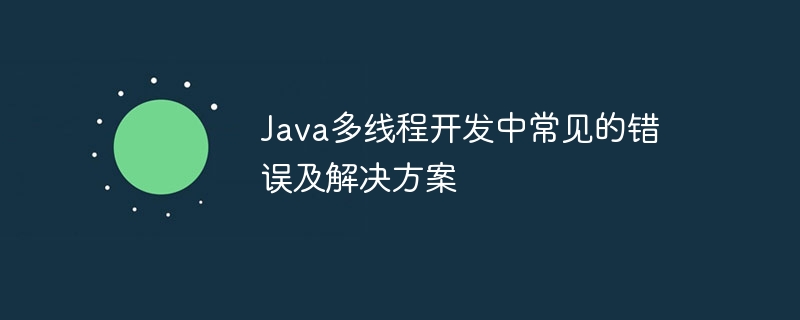Home >Java >javaTutorial >Common errors and solutions in Java multi-threaded development
Common errors and solutions in Java multi-threaded development
- 王林Original
- 2024-04-12 09:18:01663browse
In multi-threaded development, common errors and solutions include: Resource competition errors: Use synchronization mechanisms (locks or synchronized blocks) to prevent multiple threads from accessing shared resources at the same time. Deadlock errors: Use deadlock detection and prevention algorithms (timeout mechanism or hierarchical locking) to avoid waiting for mutual locks. Data inconsistency errors: Use atomic variables or immutable objects to ensure data consistency. Race condition error: Use synchronization mechanisms or encapsulated objects to ensure atomicity of variable operations. Thread safety errors: Clearly mark whether a class or method is thread safe, and use synchronization mechanisms to ensure thread safety.

Common mistakes and solutions in Java multi-threaded development
Multi-threading is an important technology to improve application performance, but Errors are prone to occur during use. Common errors and solutions are as follows:
1. Resource competition
Error:Multiple threads access the share at the same time Resources (such as variables and objects) are not synchronized.
Solution: Use a synchronization mechanism, such as a lock or a synchronized block (synchronized), to ensure that only one thread can access the resource at a time.
// 使用锁
Object lock = new Object();
synchronized (lock) {
// 操作共享资源
}2. Deadlock
Error:Multiple threads are waiting for each other to release the lock, causing the system to paralyze.
Solution: Use deadlock detection and prevention algorithms, such as timeout mechanism or hierarchical locking.
// 使用超时机制
Lock lock = ...;
try {
lock.lock(1000); // 1000ms 超时时间
// 操作共享资源
} finally {
lock.unlock();
}3. Data inconsistency
Error: Inconsistency occurs when data is shared between multiple threads due to thread switching.
Solution: Use atomic variables or immutable objects to ensure data consistency.
// 使用原子变量
AtomicInteger counter = new AtomicInteger();
// 不可变对象
final ImmutableList<String> immutableList = ImmutableList.of("a", "b", "c");4. Race condition
Error:Multiple threads modify the same variable at the same time, resulting in uncertain results.
Solution: Use synchronization mechanism or encapsulated object to ensure that variable operations are atomic.
// 使用 synchronized 方法
public synchronized int incrementCounter() {
counter++;
return counter;
}5. Thread safety
Error: The class or method does not consider multi-threading scenarios, resulting in thread insecurity.
Solution: Clearly mark whether a class or method is thread-safe, and use appropriate synchronization mechanisms to ensure thread safety.
// 声明类为线程安全
@ThreadSafe
public class MyThreadSafeClass {
// ...
}Practical case: Thread pool management
Create a thread pool to manage concurrent tasks and avoid thread creation and destruction overhead:
ExecutorService executor = Executors.newFixedThreadPool(4);
executor.submit(() -> {
// 任务逻辑
});Solution With these common mistakes, you can write safe, reliable multi-threaded Java applications.
The above is the detailed content of Common errors and solutions in Java multi-threaded development. For more information, please follow other related articles on the PHP Chinese website!

